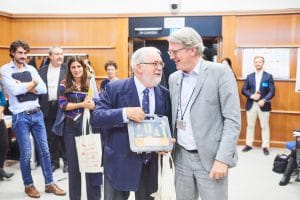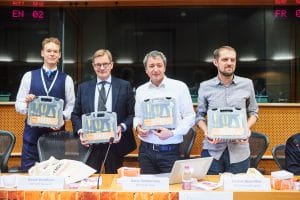COREPER on EPBD
Adrian Joyce, Renovate Europe Campaign Director
28 November 2017
Sitting side by side at Renovate Europe Day 2017 (REDay2017) on 10th October, the Estonian Presidency, Commissioner Canete and MEP Bendtsen leading the EP’s work on buildings, all agreed on the need for a strong Energy Performance of Buildings Directive (EPBD):
- – Commissioner Canete insisted “Buildings will unquestionably play a major role: we will not achieve our objectives without renovating our building stock”
- – The Estonian Presidency highlighted “Both Council and the Parliament seem to agree that the revised EPBD will contribute to the life quality of people living and working in buildings”
- – And MEP Bendtsen repeated “The ambition of the Parliament remains clear: buildings must deliver their share to become energy efficient and cost efficient”
Consensus prevailed that buildings were key to achieving the EU’s long-term top-priority goals such as job creation, climate change mitigation and digitalisation, and that the EPBD served as the perfect vehicle to push the EU forward towards a highly energy efficient, nearly zero-energy building stock for 2050.
Strongly supported by his 4 Shadow Rapporteurs also present at REDay2017, thereby representing the 5 main political parties in the EP, MEP Bendtsen walked away from the next day’s ITRE Committee Vote on the EPBD with an extremely strong report (51 votes in favour, 1 against) and an unquestionable mandate (61 votes in favour, 1 against), enshrining the European Parliament’s determination to fix the poorly-performing, energy-wasting building stock of the EU[1] with an effective toolbox of policies and incentives in the EPBD.
The EPBD toolbox which the Parliament has put on the table is the right one. This toolbox serves a clear purpose: achieving a nearly Zero Energy Building (nZEB) vision for a transformed building stock by 2050 that puts energy efficiency first; and it has the correct tools to deliver:
- – long-term national renovation strategies equipped with 2030 and 2040 milestones against which to benchmark progress using measurable progress indicators, boosting energy renovation rate and depth;
- – individual building renovation passports that empower building owners with timely, tailored and cost-effective recommendations for their building, elucidating the best moments in the life of the building for action (trigger points);
- – engagement of stakeholders in the full process of developing, implementing and evaluating long-term renovation strategies as they are competent, willing and fully resourced partners with an appetite to fully engage in the process.
All that is needed to deploy this EPBD toolbox in Member States across the EU is a successful outcome to the tripartite negotiations now taking place in Brussels between the same three representatives that were in full agreement about the importance of energy renovation at REDay2017: The Council, the Commission and the European Parliament.
Logic would assume that the debate in the trialogues would follow the same consensual statements reached at REDay2017. This would mean that:
- – The three institutions would acknowledge the good compromise that the European Parliament achieved when it adopted an EPBD text that enjoys cross-party and cross-country support with a very strong mandate.
- – EU leaders would want to demonstrate their commitment to cutting energy waste in buildings so that people all over the EU would live in warmer, more comfortable homes and work in resilient, future-proofed buildings; and
- – The trialogues would embrace the Parliament’s text as a comprehensive toolbox which will boost the staggeringly low energy renovation rates (around 1%) to a new high across the EU.
Why then do we hear of Member State resistance to improving the EU’s faltering building stock echoing strongly and persistently throughout Europe’s cold and leaky homes?
It is the turn of the Member States to grasp the toolbox with both hands and maximise the positive impact of energy renovation for the economy and for the health and comfort of citizens through the EPBD. The benefits of accelerating energy renovation across the EU have been quantified[2]: savings of €30-80 billion per year in healthcare expenditure, 8 million people could be moved out of damp, mouldy homes by 2030, 6 million lifted out of energy poverty by 2030, and local employment numbers could see a boost of 2 million direct, quality jobs.
In business, everything starts with a good long-term plan, one that sets a clear unambiguous objective, lays out milestones along the way, describes the resources needed and develops key performance indicators that allow for progress to be checked and measured. If the efforts of our Member States are to bear fruit for people, then these key elements must also feature in the final adopted text of the revised EPBD. In effect, the EPBD must become a business plan for the transformation of our building stock by 2050 to a highly energy efficient, resilient, healthy and connected stock delivering optimum living and working conditions for all Europeans.
Member States walking out of these trialogues with an EPBD text which does not set a clear 2050 nZEB vision for the building stock and does not strengthen the national renovation strategies with milestones, KPIs, resources and an implementable timeframe, will be synonymous to handing EU citizens an empty toolbox with no tools, with no plan and with no hope.
The EU and its citizens look to their governments for courageous, well-founded policies that bring benefits across the board; they do not look for more excuses for inaction. The Renovate Europe Campaign therefore calls on the Member States to ensure that the ambition shown in the Parliament’s position on the revision of the EPBD is fully contained in the final text.
Now, it’s over to you in the Council, and the world is watching!
[1] The Buildings Performance Institute Europe recently revealed that only 3% of buildings in the EU can currently be considered as highly energy efficient. See : http://bpie.eu/publication/97-of-buildings-in-the-eu-need-to-be-upgraded/
[2] Cambridge Econometrics Report presented at REDay2017: https://renovate-europe.eu/cambridge-econometrics-report-presented-reday2017/


